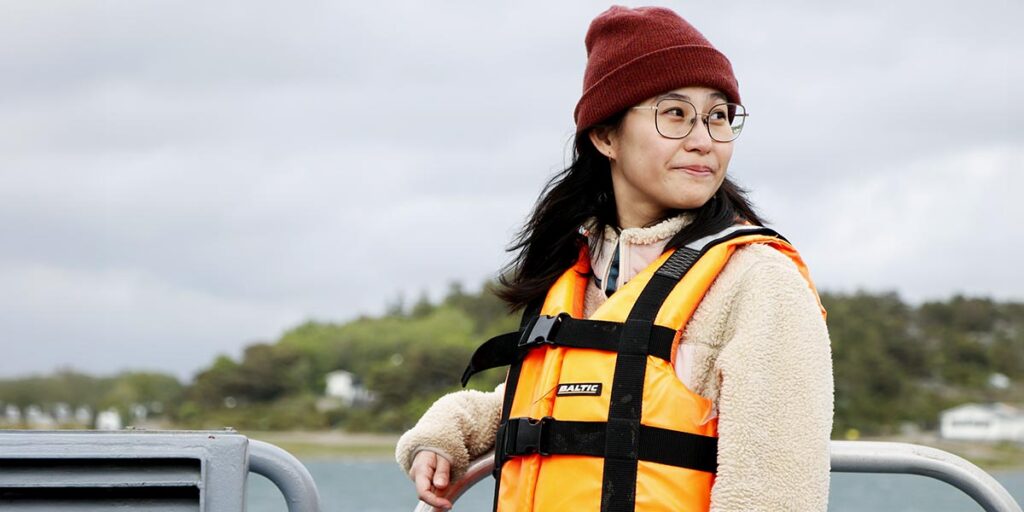
Knows weather. Climate scientist Hui-Wen Lai is part of C2B2. She investigates atmospheric conditions in the various LivingLab areas and in Scandinavia as a whole. – C2B2 is my first interdisciplinary experience in the job, she says.
In Sweden, cyclones are something we associate more with for example the waters off Japan than our own ocean basins. But they also occur in our latitudes.
– Although not as intense, says Hui-Wen Lai, meteorologist and climate scientist affiliated with C2B2.
For Hui-Wen Lai, strong winds are home turf.
– I focus on research into the atmosphere, and then you get into a number of quite difficult weather phenomena. Such as storms, heat and typhoons, she says.
To simulate weather systems and explore the processes and mechanisms, she uses different regional weather models. It is fascinating, she says, to break down natural systems using the laws of physics and mathematical equations.
– Then you realize that there is still a lot we do not know about nature.
PhD in Gothenburg
Hui-Wen is from Taiwan. She came to Sweden in 2018 with a master’s degree in atmospheric science and meteorology from Pennsylvania State University. In 2023, she defended her thesis at the Department of Geosciences in Gothenburg, a thesis on climate variations in precipitation on the Tibetan Plateau. It was supervised by Deliang Chen, professor of physical meteorology and also affiliated with the University of Gothenburg, an authority with an international reputation in climate research.
– The purpose of my thesis was to better understand precipitation patterns and the weather systems that shape them there, over the Tibetan Plateau. The results also show that high-resolution weather models can effectively simulate these processes. This helps us understand what drives changes in precipitation, both in the past and perhaps also in the future, says Hui-Wen Lai.
She is now doing her postdoctoral research in Gothenburg, and continues to investigate extreme precipitation events in Asia, also here with Deliang Chen as supervisor. Both are also connected to C2B2’s work within workpackage one which focuses on ecosystems and climate.
How did you become part of C2B2?
– They needed a climate scientist and contacted Deliang Chen, who thought we should do it together, says Hui-Wen Lai.
She now works partly with C2B2 and finds it exciting.
– It is my first interdisciplinary experience in the job. We work with researchers in natural and social sciences, and with actors from different parts of the business world who are connected to the blue economy.
Stimulating, she says, to get to know other types of issues than those she has worked with before, and to see how the different perspectives interact.
But what about marine sciences? No, she doesn’t have experience with that since before. Which of course is part of the point of the interdisciplinary approach, that expertise from different directions is gathered and pitted against each other to achieve synergistic effects.
Investigating atmospheric conditions
When it comes to Hui-Wen Lai’s own contribution within C2B2, she says that it is about making assessments of the climate and learning how it behaves in the different areas that are in focus: Skagerrak-Kattegat, the Baltic Sea and the Gulf of Bothnia.
– I investigate atmospheric conditions, such as air temperature, extreme precipitation, winds and drought. Both in the different LivingLab areas and in Scandinavia as a whole. Back to the question of typhoons – the weather phenomenon that is known, among other things, for having stopped Kublai Khan’s attempt to invade Japan in the late 13th century. According to Hui-Wen Lai, there are similar winds here in Sweden too.
– What we have here in Sweden are extratropical cyclones, strong winds and precipitation that are similar to typhoons.
It often leads to things like floods, landslides and damage to the forest.
– However, the mechanisms behind extratropical cyclones and tropical cyclones or typhoons are different, she says.
Facts: More info about Hui-Wen Lai and her research
www.gu.se/en/about/find-staff/hui-wenlai
hwlai.github.io